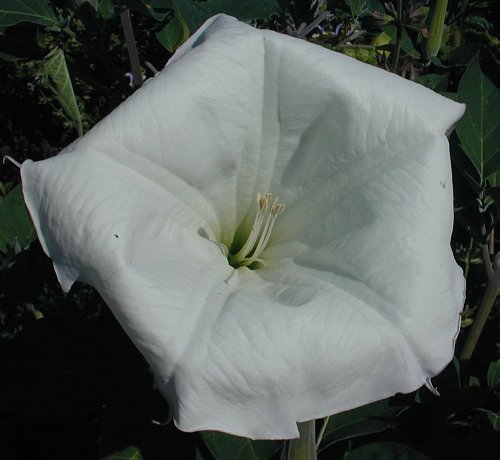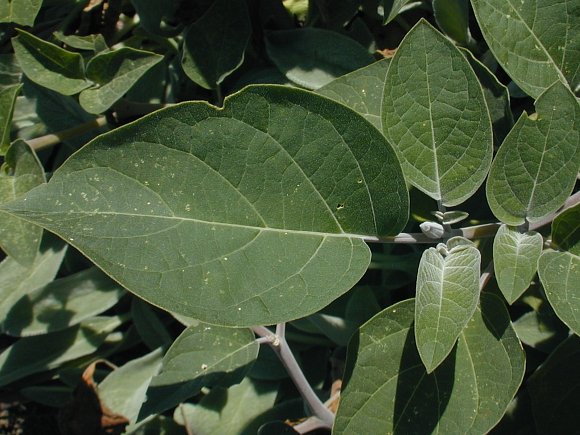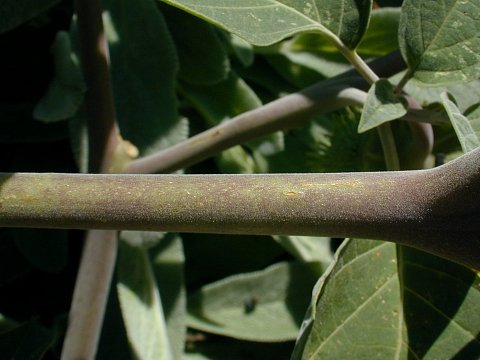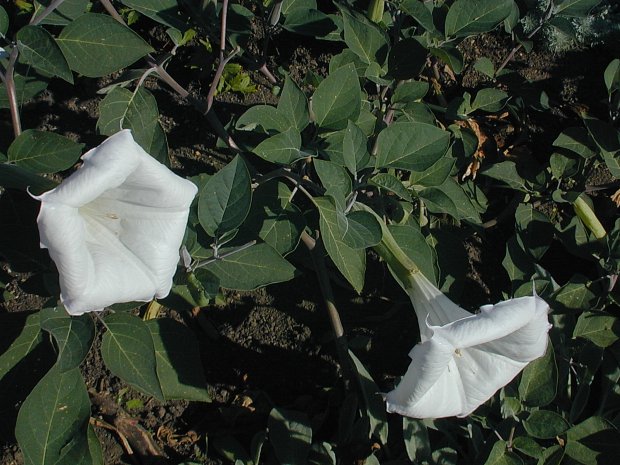Description: This plant is a perennial in areas with mild winters, otherwise it is an annual. It is about 2-4' tall and branches frequently. The smooth stems are greyish green and finely pubescent (canescent). The alternate leaves are up to 6" long and 4" across. They are ovate or cordate-ovate, smooth or slightly undulate along the margins, and finely pubescent on the underside (young leaves are finely pubescent on on the upperside as well). Each leaf is usually asymmetric at the base (oblique).

Individual flowers develop on short pedicels where the upper stems branch dichotomously. Each white flower is about 5-7" long and 3-4" across. The corolla has 5 shallow lobes that are barely perceptible; there is a short point between each pair of lobes along the rim of the corolla. Five white stamens are exerted from the center of the corolla. The base of the flower consists of a tubular calyx that has 5 broad teeth along its upper rim; this calyx extends to about ½ the length of the flower, and it lacks conspicuous ridges or wings. The blooming period occurs from mid-summer to fall and lasts about 1-2 months. The flowers often bloom during the day. Each flower is replaced by a prickly seed capsule about 1" across. Each capsule contains several seeds that are large and angular. The root system consists of a taproot. This plant reproduces by reseeding itself.

Cultivation:
The
preference is full sun, mesic conditions, and fertile loamy soil,
preferably at a site that is not too windy. Flea beetles and other
insects may chew tiny holes in the leaves.
Range & Habitat:
Angel's Trumpet has naturalized in scattered counties across Illinois,
although it rarely persists (see Distribution
Map). Habitats include areas adjacent to gardens, areas along
roads and railroads, and waste areas. This plant is occasionally
cultivated in flower gardens, from which it occasionally escapes.
Angel's Trumpet was introduced from central America and/or southwestern
United States.

Faunal
Associations:
Little is known about floral-faunal relations for this species. The
flowers are pollinated by hummingbirds and Sphinx moths. The foliage
contains stramonium (a narcotic) and probably other toxic chemicals,
therefore it is unlikely to be bothered by deer and other mammalian
herbivores.
Photographic Location:
An herb garden at Meadowbrook Park in Urbana, Illinois.

Comments: The flowers are extremely large and showy. The only other member of this genus that has naturalized in Illinois is Datura stramonium (Jimsonweed), which is common and weedy. Like Angel's Trumpet, Jimsonweed is a bushy herbaceous plant with large leaves and funnelform flowers. However, the flowers of Jimsonweed are smaller and less showy (up to 5" long and 2½" across), and they are less likely to bloom during the day. The foliage of Jimsonweed is largely hairless, while Angel's Trumpet has stems and leaf undersides that are finely pubescent. The leaf margins of Jimsonweed are lobed or undulate, while the leaf margins of Angel's Trumpet are smooth or slightly undulate. Another scientific name for Angel's Trumpet is Datura inoxia. Another common name for this species is Ghost Flower.